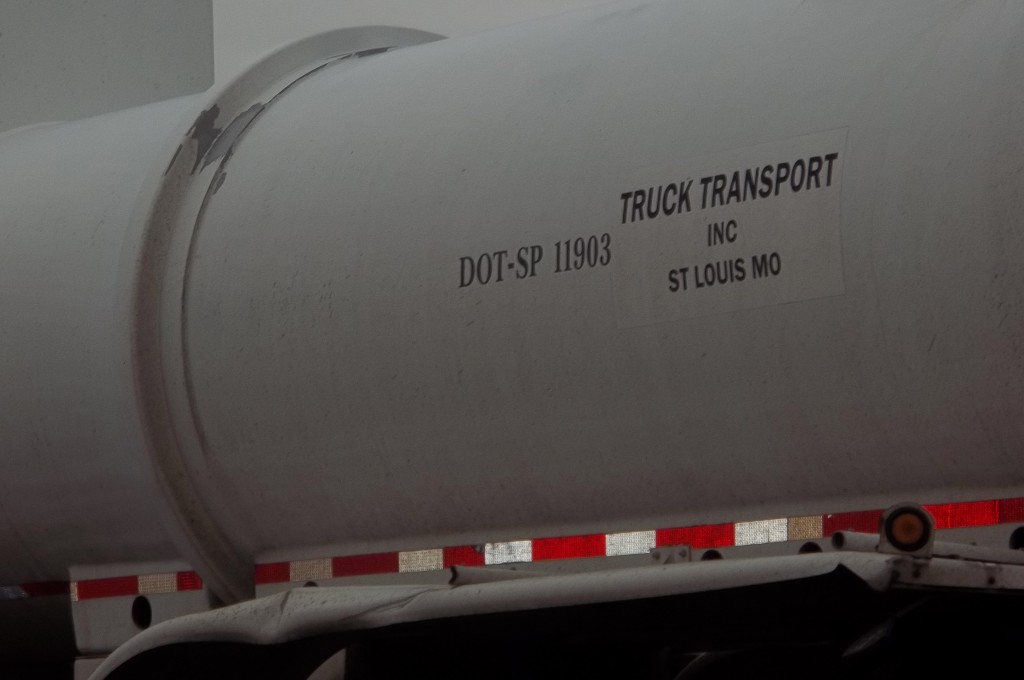I’ve seen a lot of markings on cargo tanks before, but never one like this. What’s it mean?
Truck Transport, Inc. is a name of a St. Louis, MO company I know nothing about. It’s the letters and numbers next to the name that have my interest; what does DOT-SP 11903 on a cargo tank motor vehicle mean?
DOT-SP 11903 refers to a Special Permit (“SP”) issued by the Pipeline and Hazardous Material Safety Administration (PHMSA) within the USDOT – hence the “DOT” and “11903” is the identification number it’s assigned. So we know what DOT-SP 11903 symbolizes, but what does it mean?
A Special Permit – which used to be known as an Exemption and identified by the prefix DOT-E – is a specifically issued document that authorizes a regulated shipper, carrier, or HazMat packaging manufacturer (as in this case) to conduct operations in a manner not allowed in the Hazardous Material Regulations. Basically, by complying with the requirements of the special permit you may disregard certain regulations of the HMR.
I won’t go through all the tedious details of this special permit, if interested you can do that yourself, instead I’ll summarize its high points:
- The current (tenth) revision issued May 16, 2012 expires on February 29, 2016. The Grantee or a representative will have to apply for a renewal of the special permit prior to that date. Or, it is possible that the conditions of the special permit will be incorporated into the HMR and thereby negate the need for the Special Permit.
- This Special Permit was granted to Comptank Corporation of Bothwell, Ontario, Canada. I assume that this company wanted to manufacture a type of cargo tank for sale within the US that was not authorized by the HMR. This special permit allows them to manufacture such a cargo tank and for a shipper and carrier to utilize them for the transportation in commerce of a hazardous material. From the Special Permit:
This special permit authorizes the manufacture, marking, sale and use of non-DOT specification cargo tank motor vehicles constructed from glass fiber reinforced plastics (GFRP) conforming with all regulations applicable to a DOT 407 or DOT 42 cargo tank motor vehicle except as specified herein, for the transportation in commerce of the materials listed in paragraph 6 below.
- Only the following hazardous materials may be transported in a cargo tank under this Special Permit (summarized from paragraph 6):
- Class 8 Corrosive materials authorized for transport in a lined MC-312 cargo tank and Class 8 liquid and semi-solid wastes of various descriptions and packing groups I, II, & III.
- Class 3 Flammable or Combustible liquid and semi-solid wastes of various descriptions and packing groups I, II, & III.
- Class 6.1 Poisonous/Toxic liquid and semi-solid wastes of various descriptions and packing groups I, II, & III.
- Class 9 Miscellaneous liquid and semi-solid wastes of various descriptions and packing group III.
- Section 7 Safety and Control Measures includes the following:
- Acceptable specifications for the cargo tank authorized by this Special Permit. A lot of details of interest solely to the manufacturer of the cargo tank.
- Operational controls for the shippers of HazMat and cargo tank owners using cargo tanks authorized by this Special Permit; including:
- If transporting Class 3 Flammable and Combustible Liquids the cargo tank must be equipped with a spring loaded relief valve.
- The compatibility of the cargo tank with the HazMat must be confirmed by both the shipper and the carrier prior to being offered for transportation.
- Special Provisions of Section 8:

This Special Permit allows for the transport of a hazardous material in a non-specification packaging.
- The use of this Special Permit is not limited solely to those identified by name as its holders. A person may re-ship a HazMat they received in this packaging as long as the packaging is not modified and it is offered for transportation in compliance with the HMR and DOT-SP 11903.
- A copy of the Special Permit must be maintained by the shipper of the HazMat and the manufacturer of the cargo tank. Section 10 requires a copy to be kept by the carrier as well.
- Each cargo tank authorized by this Special Permit must be marked with one of the following (I apologize; I didn’t get a picture of either one):
- Name of the manufacturer and location (city and state) of the facility where manufactured.
- A registration symbol approved by the Agency for a specific manufacturing facility.
- Information specified in Section 8(g) of the Special Permit must be plainly and durably marked on the cargo tank. Once again, I failed to get a picture!
- All HazMat Employees must receive training on the requirements of this Special Permit as it applies to their job responsibilities.
|
Contact me with any questions you may have about the transportation of hazardous materials by air, highway, vessel, or rail International and Domestic Daniels Training Services 815.821.1550 |
Don’t overlook the value a carefully crafted Special Permit can provide to your company.
